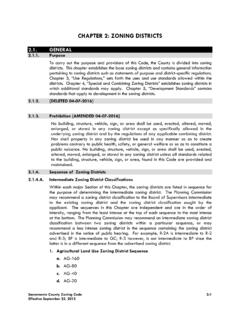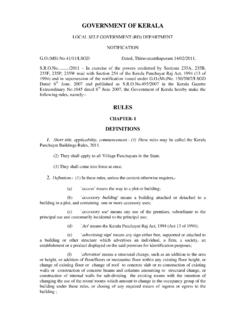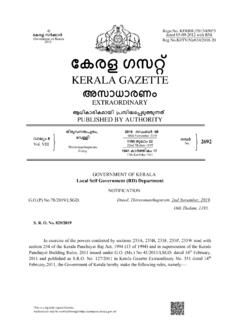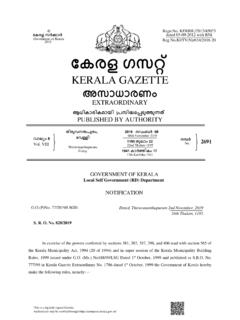Transcription of CHAPTER 5: DEVELOPMENT STANDARDS
1 Sacramento County Zoning Code Effective September 25, 2015 5-1 CHAPTER 5: DEVELOPMENT STANDARDS CHAPTER 5 describes the DEVELOPMENT STANDARDS applicable for all land use zoning districts in the unincorporated area of Sacramento County. These STANDARDS are established to preserve or enhance the urban design character of the community. They define the relationship of buildings and structures to the lot, street, parking, existing site and neighborhood context while considering the human interaction and use. The DEVELOPMENT STANDARDS contained in this CHAPTER seek to promote coordinated, sound DEVELOPMENT , effective use of land, and high quality site planning that considers the unique character and context of each unincorporated community and implements the goals and policies of the 2030 General Plan.
2 These STANDARDS also seek to encourage innovation in DEVELOPMENT and renewal to provide quality communities that meet anticipated demands for housing, services, employment, and industry; while allowing a variety of approaches to design that preserves or establishes a sense of place for each community, but does so in a healthy, safe and sustainable manner. Decisions on how and where to build homes, businesses, shopping, parks, schools all have significant impacts on human health and the natural environment. Mixed land uses (job/housing/retail proximity), community connectivity, and active transportation choices all promote and increase walking and physical activity. By incorporating Active Design, identified by the icon at left, and other design considerations into the built environment, physical activity and improved health can be achieved.
3 Utilizing Crime Prevention through Environmental Design (CPTED) strategies can also enhance the urban design character by discouraging crime and an enhanced sense of community safety. The County Design Guidelines seek to promote quality designs that reflect the community character and among other things promotes public health, safety, and livability through design of the built environment. Active Designs and CPTED strategies are discussed further in the County s Design Guidelines. Due to the wide range of communities in unincorporated Sacramento County, concepts of community character and context are introduced in this CHAPTER to balance the need to be sensitive to differences among communities, with the need for flexibility and understandable and manageable guidance for DEVELOPMENT .
4 It is recognized that some STANDARDS will not always work for all situations. Thus, the Design Review process, required for single-family and multi-family residential and non-residential DEVELOPMENT projects, will be used to approve alternative STANDARDS or solutions that differ in some respects, but are substantially consistent with the County s DEVELOPMENT STANDARDS and design guidelines. Project applicants should consult with the County early in the design stages of the project to ensure compliance with all applicable Code requirements. This CHAPTER contains General STANDARDS , Off-Street Parking, and Sign Regulations that are applicable to all land use zoning districts in the County; and DEVELOPMENT STANDARDS applicable to each of the land use zoning districts in the County: CHAPTER Format and Use of DEVELOPMENT STANDARDS INTRODUCTION Purpose Sacramento County Zoning Code Effective September 25, 2015 5-2 CHAPTER 5.
5 DEVELOPMENT STANDARDS Section Introduction Section CHAPTER Format and Use of DEVELOPMENT STANDARDS Section General STANDARDS and Exceptions Section Agricultural, Agricultural-Residential, and Recreational Zoning Districts Section Residential Zoning Districts Section Commercial Zoning Districts Section Industrial and Industrial Park Zoning Districts Section Mixed-Use Zoning Districts Section Institutional Uses [DELETED 07-16-2020] Section Off-Street Parking Section Sign Regulations DEVELOPMENT STANDARDS set the specific requirements for each project or design solution. They define the dimensional requirements that apply to structures built within each of the land use zoning districts, including required lot sizes, lot coverage; setbacks; building and structure heights; and other requirements related to the building envelope, location, and configuration of buildings and structures.
6 DEVELOPMENT STANDARDS in this Code are structured by topic areas and ensure projects within each of the County s land use zoning districts are compatible and sensitive to the context of the existing community. To understand the complete application of all DEVELOPMENT and design requirements, the user of this code should review the DEVELOPMENT STANDARDS Section for the applicable land use zoning district of the project, including Section , Off-Street Parking and Section , Sign Regulations. Additional STANDARDS apply to certain uses and in special zoning districts, as specified in Chapters 3, Use STANDARDS and CHAPTER 4, Special and Combining Zoning Districts. CHAPTER 7, Definitions should be consulted for the terms used in this CHAPTER .
7 DEVELOPMENT and design STANDARDS in this Code set the basic, often quantitative requirements for DEVELOPMENT that supports the goals and policies of the County s 2030 General Plan and should be referenced in conjunction with the County s Design Guidelines for expectations on the qualitative design criteria that will be used to evaluate DEVELOPMENT projects during the Design Review process. DEVELOPMENT examples, where provided in this Code, illustrate typical or possible building types and designs that are encouraged, but are not intended to encompass all possible sol utions or examples that may be permitted in the County. Sacramento County Zoning Code Effective September 25, 2015 5-3 CHAPTER 5: DEVELOPMENT STANDARDS Section General STANDARDS and Exceptions Section Setback STANDARDS for All Zoning Districts Storage and Accumulation of Junk, Garbage, and Rubbish.
8 It shall be unlawful for any person to store or keep, or permit others to store or keep, junk, garbage, and/or rubbish including, but not limited to, scrap metals or other scrap materials, on any lot or parcel, or any portion thereof, in any zone other than the M-2 zone subject to the requirements for that zone. [DELETED 07-16-2020] Refer to Section Measuring Setbacks Street right-of-way dimensions and width are described in the adopted County Improvement STANDARDS . Setbacks in the Zoning Code are identified and measured, based on one of two approaches, depending on whether the street right-of-way or future street right-of-way includes or does not include a Public Utilities and Public Facilities (PUPF) easement. Prior to the adoption of the revised County Improvement STANDARDS in 2009, buildings setbacks were historically measured from the back of the sidewalk.
9 The revised County Improvement STANDARDS include provisions for a PUPF easement overlaying the landscape buffer and sidewalk area, where the right-of-way is now measured from the back of the curb. The Zoning Code reflects the existence of both methods for measuring setbacks from the public street right-of-way, as indicated in the DEVELOPMENT Standard Tables for each zoning district. Developments that acquired right-of-way prior to adoption of the 2009 Improvement STANDARDS shall follow the STANDARDS for setbacks without a PUPF easement, using setbacks measured from the back of the sidewalk. New or recent right-of-way acquisitions with setbacks that include a PUPF easement shall be measured from the back of curb. Where there is no street right-of-way, access easement, or future street right-of-way, as identified through an official control or private road, a setback is measured from the property line.
10 The descriptions and accompanying diagrams in Figures 5-1 through 5-8 define the front, side, and rear yard areas and the methods for measuring setbacks. Setback STANDARDS for All Zoning Districts GENERAL STANDARDS AND EXCEPTIONS Prohibited Activities Sacramento County Zoning Code Effective September 25, 2015 5-4 CHAPTER 5: DEVELOPMENT STANDARDS Section General STANDARDS and Exceptions Section Setback STANDARDS for All Zoning Districts Figure 5-1: Typical Lot Identifying Yard Areas 1. Front Yard Setback. The front yard setback is the depth, measured perpendicularly from the nearest point of the front lot line, at the back of the sidewalk, to the nearest part of the main building. Where a PUPF is required, setbacks shall be measured from the back of the curb to the main building.





